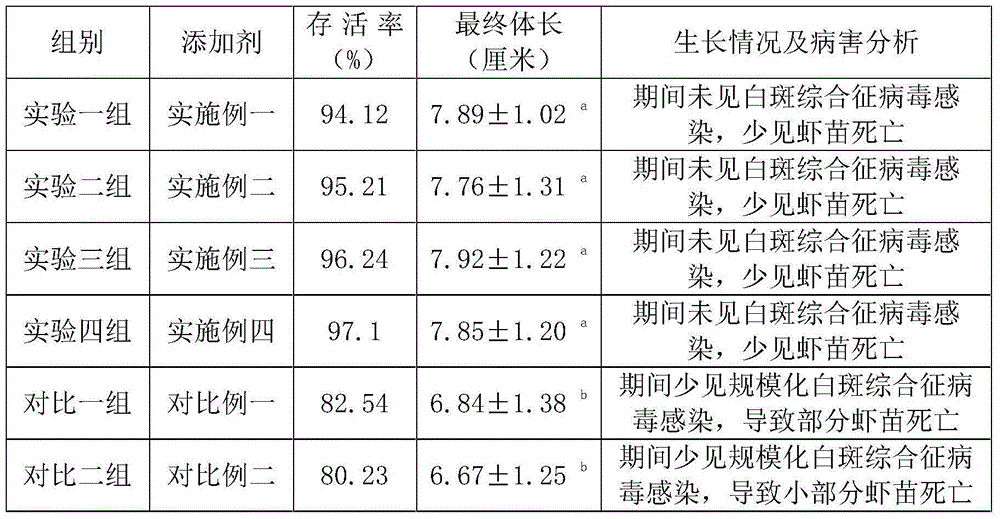Feed additive capable of reducing white spot syndrome virus disease of penaeus vannamei boone
A feed additive and white spot syndrome technology, which is applied in antiviral agents, animal feed, animal feed, etc., can solve the problems of water body enrichment and oxidation, achieve the effects of purifying water quality, inhibiting white spot syndrome virus disease, and improving economic benefits
- Summary
- Abstract
- Description
- Claims
- Application Information
AI Technical Summary
Problems solved by technology
Method used
Image
Examples
Embodiment 1
[0026] Weigh the following components in parts by weight: 0.5 parts of photosynthetic bacteria, 0.2 parts of Bacillus subtilis, 1 part of glucose, 2 parts of acacia, 3 parts of perilla, 5 parts of green bark, 1 part of cassia twig, 3 parts of white peony, vitamin C 0.01 parts, vitamin K 0.01 parts, carrier 15 parts. Firstly, five kinds of traditional Chinese medicines including acacia, perilla, green bark, cassia twig, and white peony are mixed and crushed through a sieve with an aperture of 300-500 microns, and then the powder is mixed with the weighed photosynthetic bacteria, Bacillus subtilis, glucose, vitamin C, and vitamin K , Carrier mix, stir evenly and pack.
Embodiment 2
[0028] Weigh the following components in parts by weight: 2 parts of photosynthetic bacteria, 1 part of Bacillus subtilis, 2 parts of glucose, 4 parts of acacia, 5 parts of perilla, 6 parts of green bark, 4 parts of cassia twig, 7 parts of white peony root, vitamin C 0.5 parts, vitamin K 0.05 parts, carrier 20 parts. Firstly, five kinds of traditional Chinese medicines including acacia, perilla, green bark, cassia twig, and white peony are mixed and crushed through a sieve with an aperture of 300-500 microns, and then the powder is mixed with the weighed photosynthetic bacteria, Bacillus subtilis, glucose, vitamin C, and vitamin K , Carrier mix, stir evenly and pack.
Embodiment 3
[0030] Weigh the following components in parts by weight: 1.2 parts of photosynthetic bacteria, 0.5 parts of Bacillus subtilis, 1.3 parts of glucose, 4 parts of acacia, 5 parts of perilla, 5 parts of green bark, 3 parts of cassia twig, 4 parts of white peony, vitamin C 0.5 parts, vitamin K 0.03 parts, carrier 19 parts. Firstly, five kinds of traditional Chinese medicines including acacia, perilla, green bark, cassia twig, and white peony are mixed and crushed through a sieve with an aperture of 300-500 microns, and then the powder is mixed with the weighed photosynthetic bacteria, Bacillus subtilis, glucose, vitamin C, and vitamin K , Carrier mix, stir evenly and pack.
PUM
 Login to View More
Login to View More Abstract
Description
Claims
Application Information
 Login to View More
Login to View More - R&D
- Intellectual Property
- Life Sciences
- Materials
- Tech Scout
- Unparalleled Data Quality
- Higher Quality Content
- 60% Fewer Hallucinations
Browse by: Latest US Patents, China's latest patents, Technical Efficacy Thesaurus, Application Domain, Technology Topic, Popular Technical Reports.
© 2025 PatSnap. All rights reserved.Legal|Privacy policy|Modern Slavery Act Transparency Statement|Sitemap|About US| Contact US: help@patsnap.com

